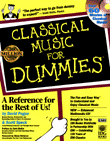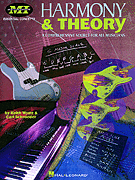Theory & General Music Books
 Classical
Music for Dummies: No home should be without it! Every time you turn
around, those guys at IDG Books have
a new 'Dummies' title on the shelf. Classical Music for Dummies is no
disappointment. It's chocked full of good hard information, but written with tongue in
cheek. Included it action-packed chapters are a complete history of western music, an
unbelievable chapter on music theory (by itself worth the price of the whole book), top
ten lists, a CD-ROM and other enticements to get you and your family more involved as
music listeners. Available at most larger bookstores for $24.95.
Classical
Music for Dummies: No home should be without it! Every time you turn
around, those guys at IDG Books have
a new 'Dummies' title on the shelf. Classical Music for Dummies is no
disappointment. It's chocked full of good hard information, but written with tongue in
cheek. Included it action-packed chapters are a complete history of western music, an
unbelievable chapter on music theory (by itself worth the price of the whole book), top
ten lists, a CD-ROM and other enticements to get you and your family more involved as
music listeners. Available at most larger bookstores for $24.95.
 Master Theory Workbook: Cheap, Easy & Thorough - As
a teacher who strives to get students the 'jamming' skills that they need to play in the
real world, I know the need for good basic non-egghead musical knowledge. This can be a
tall order for wind instrument students. First, the book must teach them the theory
knowledge that is relevant to what they do. Second, it must be usable (and the work
checkable) with a minimum of supervision. Third, it must function for those who do not
have a piano or guitar at home. And finally, it must be written in universal musical
terms--illustrated with notes on the staff rather than piano keys or guitar tabliture.
Master Theory Workbook: Cheap, Easy & Thorough - As
a teacher who strives to get students the 'jamming' skills that they need to play in the
real world, I know the need for good basic non-egghead musical knowledge. This can be a
tall order for wind instrument students. First, the book must teach them the theory
knowledge that is relevant to what they do. Second, it must be usable (and the work
checkable) with a minimum of supervision. Third, it must function for those who do not
have a piano or guitar at home. And finally, it must be written in universal musical
terms--illustrated with notes on the staff rather than piano keys or guitar tabliture.
I've kissed a lot of frogs in search of such a book, and so far only one
prince has appeared. That prince is the Master Theory Workbook, a 6-volume compilation
published by Neil A. Kjos. After completing the first three books (90 lessons
total) a student can write out a simple familiar song, add a harmony part, and select the
chords for accompaniment. At this point, they are bridging the gap between the worlds of
those who play from sheet music and those who play by ear. (this is why I include
references to Master Theory lessons in the activities section of
this website)
Important Note: While this is written, academic work, it
also involves skillbuilding. This means that lessons are not to be rushed through as soon
as written work is completed. Rhythmic exercises must be performed by the student in real
time, and ear training exercises must be realized in audio on the student's instrument.
With my private students (whom I see only once a week) I rarely recommend doing more than
one lesson per day, and never assign more than four lessons per week. (it's usually more
like two lessons per week) This work is to be digested and savored, not rushed
through. Completed books should be kept for future reference.
 Harmony
& Theory: A Comprehensive Resource for All Musicians - (by Keith Wyatt
& Carl Schroeder, Musicians Institute Press, Hal
Leonard, Inc.) Music harmony and theory are not rules that someone makes up.
They occur naturally in practice and the theorists simply codify them for the rest of us
to understand. In the 18th century, J. S. Bach observed, codified and even personified the
rules that classical musicians have cherished and wrestled with for over 200 years. Then,
in the 20th Century, popular music began to slide away from from some of these rules and
much of the nomenclature. Bach couldn't possibly have envisioned the impact of the blues,
the return of the church modes, the guitar revolution or the flirtations with world music
that have invaded the vernacular of popular music today.
Harmony
& Theory: A Comprehensive Resource for All Musicians - (by Keith Wyatt
& Carl Schroeder, Musicians Institute Press, Hal
Leonard, Inc.) Music harmony and theory are not rules that someone makes up.
They occur naturally in practice and the theorists simply codify them for the rest of us
to understand. In the 18th century, J. S. Bach observed, codified and even personified the
rules that classical musicians have cherished and wrestled with for over 200 years. Then,
in the 20th Century, popular music began to slide away from from some of these rules and
much of the nomenclature. Bach couldn't possibly have envisioned the impact of the blues,
the return of the church modes, the guitar revolution or the flirtations with world music
that have invaded the vernacular of popular music today.
As a result, many fine music students graduate from high school, college, and private
lessons without a solid understanding of principles and nomenclature that are in common
use in recording studios or by the band in their corner bar. Much of this is because
popular music is developed by musicians with a minimum of formal schooling, who create
their own solutions to the problems that confront them.
Fortunately for us all, pop and jazz musicians have also become dedicated educators,
trying to spread the practical knowledget that they worked so hard to gain. Schools like
Boston's Berklee College or Southern California's Musician's Institute are leading the
way. And forward-looking publishers like Hal Leonard are helping them to disseminate their
texts.
At $17.95, Harmony & Theory is not a cheap publication but it is a practical,
real-world guide to understanding music and communicating with other musicians. Its 157
pages are divided into three sections: 1) The Tools: a review of the basics, 2)
Structures: chords and chord progressions, and 3) Variations: melody and harmony in the
real world.
I just bought my first copy of this book a week before posting this review. I'm already
so impressed, that I plan to add it to the curriculum for my private students.
Available thru Hal Leonard Publishing.
Back to Music Books
Back to Music
Consumer Page
Home
Email me
 Classical
Music for Dummies: No home should be without it! Every time you turn
around, those guys at IDG Books have
a new 'Dummies' title on the shelf. Classical Music for Dummies is no
disappointment. It's chocked full of good hard information, but written with tongue in
cheek. Included it action-packed chapters are a complete history of western music, an
unbelievable chapter on music theory (by itself worth the price of the whole book), top
ten lists, a CD-ROM and other enticements to get you and your family more involved as
music listeners. Available at most larger bookstores for $24.95.
Classical
Music for Dummies: No home should be without it! Every time you turn
around, those guys at IDG Books have
a new 'Dummies' title on the shelf. Classical Music for Dummies is no
disappointment. It's chocked full of good hard information, but written with tongue in
cheek. Included it action-packed chapters are a complete history of western music, an
unbelievable chapter on music theory (by itself worth the price of the whole book), top
ten lists, a CD-ROM and other enticements to get you and your family more involved as
music listeners. Available at most larger bookstores for $24.95.
